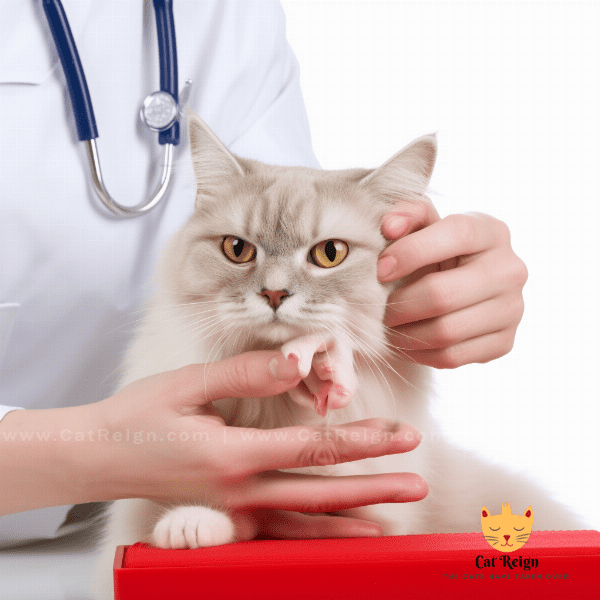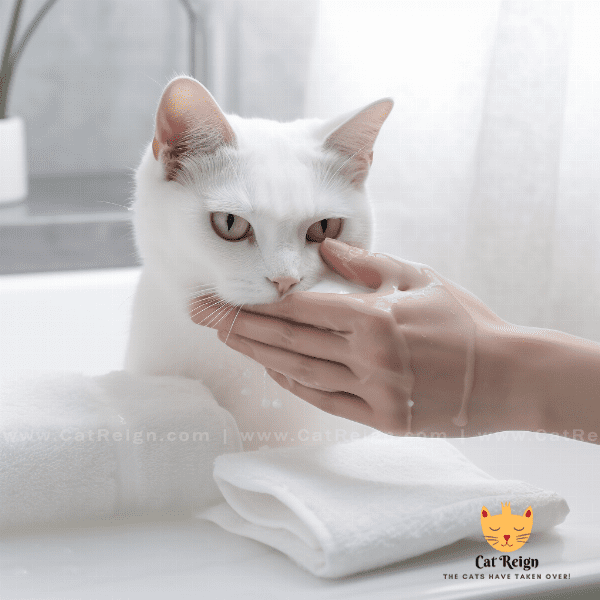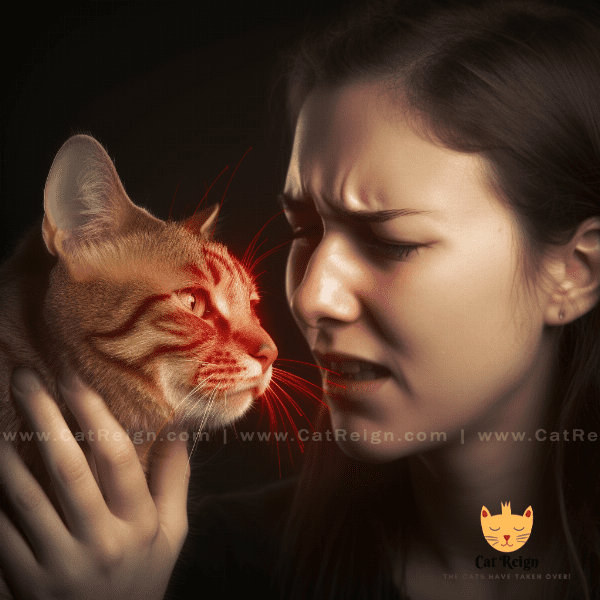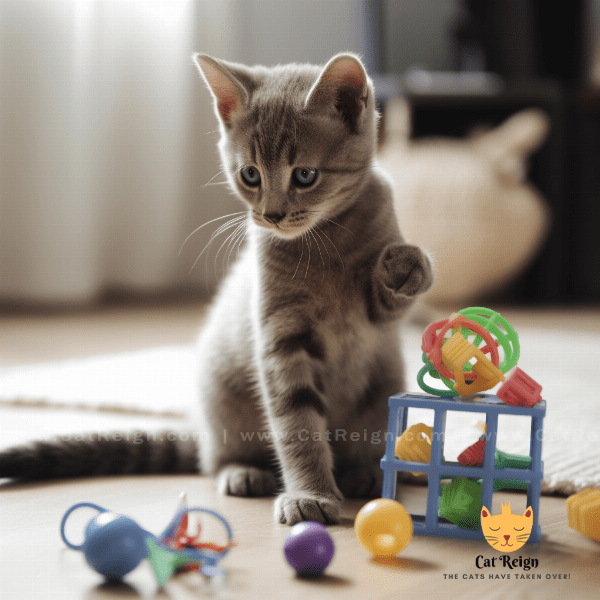Table of Contents
How it happened
It’s not uncommon for cats to bite their owners or other people, but when it happens to you, it can be a surprising and painful experience. Understanding what led to the bite can help you prevent future incidents.
The circumstances leading up to the bite
Was your cat playing when it bit you, or was it a response to something else? Cats can become overstimulated during playtime and bite, so it’s important to watch for signs that your cat is getting too excited. Other possible reasons for a bite could be fear, stress, or feeling threatened.
The warning signs
Cats usually give warnings before they bite, such as a flicking tail, flattened ears, or dilated pupils. It’s important to recognize these signals and give your cat space if they’re feeling uncomfortable.
The actual bite
When a cat bites, it can happen quickly and without warning. It’s important to remain calm and not pull away, as this can cause further injury. Instead, try to gently push your cat away or distract them with a toy.
The aftermath
After the bite, you may be left with a painful wound that can take some time to heal. It’s important to clean the wound thoroughly and seek medical attention if necessary. You may also feel a range of emotions, from anger to sadness, which is normal. Remember to take care of yourself and reach out to others for support.
Understanding the circumstances surrounding your cat’s bite can help you prevent future incidents and strengthen your bond with your pet.

Assessing the injury
After a cat bite, it’s important to assess the injury to determine the appropriate course of action. Here are some things to consider:
The severity of the bite
Cat bites can range from mild to severe, depending on the depth and location of the wound. A shallow bite on the arm or leg may only require basic first aid, while a deep bite on the face or neck may require immediate medical attention.
The risk of infection
Cat bites can easily become infected, as cats’ mouths contain a variety of bacteria. It’s important to clean the wound thoroughly with soap and water and apply an antiseptic to reduce the risk of infection. If you notice any signs of infection, such as redness, swelling, or pus, seek medical attention immediately.
The emotional impact
In addition to physical injury, a cat bite can also have a psychological impact. You may feel anxious or fearful around your cat, or experience symptoms of post-traumatic stress disorder (PTSD). It’s important to seek help if you’re struggling to cope with the emotional aftermath of a cat bite.
Assessing the injury after a cat bite can help you determine the appropriate course of action and reduce the risk of complications. Remember to take care of both your physical and emotional health after a bite.

Treating the wound
After a cat bite, it’s important to take steps to treat the wound and reduce the risk of infection. Here are some things you can do:
Clean the wound
Immediately after the bite, wash the wound thoroughly with soap and water. This will help remove any bacteria that may have entered the wound. If the wound is deep, you may want to apply pressure to help stop the bleeding.
Apply an antiseptic
After cleaning the wound, apply an antiseptic such as hydrogen peroxide or rubbing alcohol to help kill any remaining bacteria. You may also want to apply a topical antibiotic ointment to help prevent infection.
Cover the wound
Covering the wound with a sterile bandage can help protect it from further bacteria and prevent further injury. Be sure to change the bandage regularly and watch for signs of infection.
Monitor for signs of infection
Even with proper treatment, a cat bite can still become infected. Watch for signs of redness, swelling, warmth, or pus around the wound. If you notice any of these symptoms, seek medical attention immediately.
Seek medical attention if necessary
If the wound is deep or shows signs of infection, you may need to seek medical attention. Your doctor may prescribe antibiotics or recommend a tetanus shot if necessary.
Treating the wound after a cat bite is important to prevent infection and promote healing. Remember to monitor the wound and seek medical attention if necessary.

Understanding cat behavior
Understanding your cat’s behavior can help you prevent future incidents of biting. Here are some things to keep in mind:
Cats use biting as a form of communication
Cats communicate through body language, vocalizations, and behavior. Biting can be a way for cats to communicate that they are feeling uncomfortable or threatened. It’s important to pay attention to your cat’s body language and give them space if they are feeling stressed.
Cats have different personalities
Just like people, cats have their own unique personalities. Some cats may be more aggressive or territorial than others, while some may be more timid or fearful. Understanding your cat’s personality can help you anticipate and prevent situations that may lead to biting.
Cats can become overstimulated
Cats are known for their playful and curious nature, but they can become overstimulated during playtime. This can lead to biting or scratching. Watch for signs that your cat is getting too excited, such as dilated pupils, a lashing tail, or aggressive behavior.
Cats may bite to establish dominance
In multi-cat households, cats may bite each other to establish dominance. It’s important to ensure that each cat has their own space and resources, such as food and water bowls, litter boxes, and resting areas.
Cats may bite when in pain
Cats may also bite when they are in pain or discomfort. It’s important to watch for signs of illness or injury in your cat and seek veterinary attention if necessary.
Understanding your cat’s behavior can help you prevent future incidents of biting. Remember to pay attention to your cat’s body language and personality, and provide them with the resources and space they need to feel comfortable and safe.

Preventing future bites
Preventing future bites from your cat requires a combination of understanding their behavior and taking proactive steps to prevent situations that may lead to biting. Here are some things you can do:
Observe your cat’s behavior
Watch for signs that your cat is feeling stressed, overstimulated, or uncomfortable. This can include dilated pupils, flattened ears, or a lashing tail. If you notice these signs, give your cat space and allow them to calm down.
Be cautious when introducing new people or animals
Introducing new people or animals to your cat can be stressful for them, and may lead to biting or aggressive behavior. It’s important to introduce new people or animals slowly and under supervision.
.
When to seek medical attention
The bite is deep or located on the face or neck
If the bite is deep or located on the face or neck, it may require stitches or other medical treatment. This is especially important if the wound is bleeding heavily or is difficult to clean.
The wound shows signs of infection
If the wound becomes red, swollen, warm, or starts to discharge pus, it may be infected. Infection can spread quickly, so it’s important to seek medical attention if you notice these symptoms.
You develop a fever or other systemic symptoms
If you develop a fever, chills, or other systemic symptoms after a cat bite, it may be a sign that the infection has spread beyond the wound. Seek medical attention immediately if you experience these symptoms.
You haven’t had a tetanus shot in over 10 years
If it’s been more than 10 years since your last tetanus shot, you may need a booster after a cat bite. Tetanus is a serious bacterial infection that can be life-threatening if left untreated.
You’re unsure about the severity of the bite
If you’re unsure about the severity of the bite, it’s always better to err on the side of caution and seek medical attention. A healthcare professional can assess the wound and determine if further treatment is necessary.
Remember to monitor the wound and seek medical attention if necessary after a cat bite. Early treatment can help prevent complications and promote healing.

Dealing with the emotional aftermath
Experiencing a cat bite can be a traumatic event that can leave you with a range of emotions, from anger to fear. Here are some tips for dealing with the emotional aftermath of a cat bite:
Acknowledge your feelings
It’s important to acknowledge and process your feelings after a cat bite. You may feel angry at your cat, or fearful of being bitten again. Recognize that these emotions are normal and valid.
Reach out for support
Talking to friends or family members about your experience can help you process your emotions and feel less alone. You may also want to consider seeking professional help, such as counseling or therapy.
Practice self-care
Taking care of yourself is important after a traumatic event. Make sure to eat well, exercise, and get enough sleep. Engage in activities that bring you joy and help you relax, such as reading or listening to music.
Work on rebuilding trust with your cat
After a cat bite, it’s natural to feel wary of your cat. Working on rebuilding trust can help strengthen your bond and prevent future incidents of biting. Spend time playing with your cat, giving them treats, and rewarding positive behavior.
Consider seeking help for your cat’s behavior
Dealing with the emotional aftermath of a cat bite can take time, but with the right support and self-care, you can move forward and rebuild your relationship with your cat.

Training your cat
Use positive reinforcement
Positive reinforcement is a training technique that rewards good behavior with treats or praise. When your cat exhibits good behavior, such as not biting, reward them with a treat or verbal praise.
Avoid punishment
Punishing your cat for biting, such as hitting or yelling at them, can make the behavior worse and damage your relationship with your pet. Instead, focus on rewarding positive behavior and redirecting negative behavior.
Be consistent
Consistency is key when training your cat. Make sure that everyone in your household is on the same page when it comes to training and that you’re consistently rewarding positive behavior and redirecting negative behavior.
Training your cat takes time and patience, but with positive reinforcement and consistency, you can help prevent future incidents of biting and strengthen your bond with your pet. Remember to provide appropriate toys and playtime, establish clear boundaries, and avoid punishment.

Protecting others from your cat
If your cat has a history of biting, it’s important to take steps to protect others from potential harm. Here are some tips for protecting others from your cat:
Warn visitors
If you’re having visitors over, it’s important to warn them about your cat’s biting history. Let them know what to expect and how to interact with your cat.
Keep your cat in a separate room
If you’re unable to supervise your cat, consider keeping them in a separate room away from visitors or children. Make sure they have access to food, water, and a litter box.
Use a leash or carrier
When taking your cat outside or to the vet, use a leash or carrier to prevent them from biting or scratching. This can also help prevent your cat from getting into dangerous situations.
Consider using a muzzle
In severe cases, you may want to consider using a muzzle to prevent your cat from biting. Make sure to use a properly fitted muzzle and supervise your cat at all times.
Seek professional help
Protecting others from your cat is important to prevent potential harm. Remember to warn visitors, keep your cat in a separate room, and use a leash or carrier when necessary. If necessary, seek professional help to address your cat’s biting behavior.

Conclusion and final thoughts
Experiencing a cat bite can be a traumatic event, but with proper treatment and understanding of your cat’s behavior, you can prevent future incidents and strengthen your bond with your pet. Here are some final thoughts to keep in mind:
Take cat bites seriously
While most cat bites can be treated at home with basic first aid, some bites may require medical attention. It’s important to monitor the wound and seek medical attention if necessary to prevent complications.
Understand your cat’s behavior
Understanding your cat’s behavior can help you prevent future incidents of biting. Cats use biting as a form of communication, and can become overstimulated or aggressive in certain situations.
Practice positive reinforcement and training
Training your cat using positive reinforcement techniques can help prevent future incidents of biting and strengthen your bond with your pet.
Protect others from your cat
If your cat has a history of biting, it’s important to take steps to protect others from potential harm. Warn visitors, keep your cat in a separate room, and use a leash or carrier when necessary.
Seek professional help if necessary
Remember to practice proper wound care and seek medical attention if necessary after a cat bite. Understanding your cat’s behavior and practicing positive reinforcement and training can help prevent future incidents of biting and strengthen your bond with your pet.




